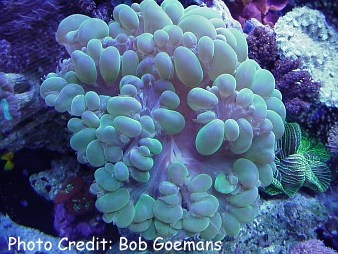
By Bob Goemans

Likely Reef Tank Suitable
Likely Fish-Only Tank Suitable
Range: Indo-West Pacific Ocean: Red Sea, East Africa, Maldives, Malaysia, Papua New Guinea, Philippines, to the Solomon Islands and Australia.
Natural Environment: Inhabits protected shaded areas receiving gentle water movement on lower reef slopes, under overhangs, and cave walls, and typically found in a vertical position. When found in moderately lit areas, the waters are somewhat turbid and usually seen at depths between 3 to 65 feet (1 - 20 m).
General Husbandry: Common in the trade.
It is thought the size of the bubbles, usually .5 to 1.0 inch (1 - 2.5 cm) in length, sometimes larger, regulate the amount of light its zooxanthellae receive, since this coral does not photoadapt, i.e., adjusts its level of photosynthetic cells to match light intensity. It simply regulates how much light they see with bubble size. Therefore proper placement is extremely important. Generally, most prefer low light and do better with indirect light and gentle water movement. Yet, some specimens seem to do well in direct light provided by fluorescent lamps, but would not recommend strong direct light from powerful metal halide lamps or LED's.
At night, the bubbles retract somewhat and the coral displays long sweeper tentacles, sometimes 3 or 4 inches (7.5 - 10 cm) in length that can sting downstream neighbors within reach. They are also capable of stinging human flesh, so be forewarned. It should be noted the short tentacles associated with the bubbles during the day do not contain stinging cells, yet the sweepers extended during the night do contain stinging nematocysts.
The most common color is tan, yet some specimens exhibit a pale green or pink tinge. Some light tan to almost white colored specimens probably received slightly more light than darker brown specimens. Those with colored tints require slightly better lighting than brown or tan specimens. Some bubbles appear to have a fingerprint pattern on their surface.
Even though a photosynthetic stony coral, its also a suspension feeder and accepts zooplankton when its feeding tentacles are displayed. When I feed my aquarium, if feeding tentacles are displayed, I directly dose the polyps with meaty foodstuffs, e.g., fortified brine shrimp, mysis, rotifers, and/or products containing Cyclop-eeze. Nevertheless, I have often found overfeeding or with large pieces of marine flesh to cause the specimen to go through odd shape changes that seem to affect its longevity. Therefore, if the decision is made to feed, do so sparingly, e.g., twice monthly.
Keep in mind if the water movement is too swift, the bubbles will not fully expand, detracting from the natural nourishment provided by the zooxanthellae on the surface of each bubble.
Taxonomy:
Kingdom: Animalia
Phylum: Cnidaria
Class: Anthozoa
Subclass: Hexacorallia
Order: Scleractinia
Family: Euphyllidae
Genus: Plerogyra
FYI: Its skeleton develops a somewhat flattened; yet continuous and unbranched wall of fused vertical plates (septa) and in the wild is generally pale grey or dull green. Specimens over 3 feet (1 m) across have been seen in the wild.
Since the animal's septa, i.e., the upright large blade-like structures that extend above the corallite walls are quite sharp and somewhat thin, handling during collection and shipping can easily damage this skeleton material and associated tissue. It's always better to select a specimen that looks healthy and shows no signs of damage or tissue recession, or has any kind of alga growth (brown or green) on any exposed skeleton surface. And do not remove a specimen with fully inflated bubbles from the water as the weight of the water in the bubbles may damage or tear its flesh. Gently shake the specimen and allow the bubbles to retract somewhat before removing.
Experience Level: Intermediate
Diet: Photosynthetic/Plankton feeder
Temperament: Aggressive
Aquarium Environment: Reef or fish-only aquarium
Coral Safe: With caution
Fish Safe: Yes
Invertebrate Safe: Yes
Acclimation Time: 30 minutes+
Aquarium Hardiness: Hardy
Calcium (Ca): 380 - 430 mg/l
Alkalinity: 2.5 - 3.0 meq/l
Phosphate (PO4): <0.05 mg/l
Magnesium (Mg): approx. 1350 mg/l (relate to specific gravity)
Strontium (Sr) 8 - 10 mg/l
Temperature Range: 74 - 83°F (23 - 28°C)
Minimum Tank Size: 50 gallons
Lighting: PAR 250 - 400+
Water Movement: WM 1 - 2
Specific Gravity: 1.023 - 1.025
pH: 8.0 - 8.4
Iodine/Trace Elements Monitor/as necessary to maintain quality seawater.
